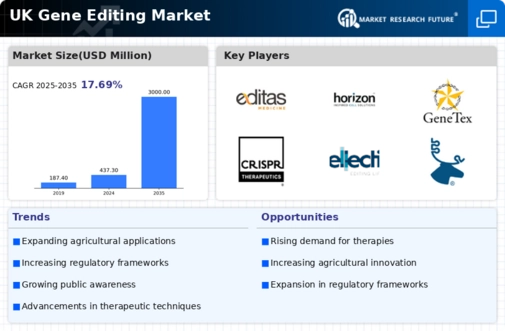Advancements in Biotechnology
The gene editing market is experiencing a surge due to rapid advancements in biotechnology. Innovations in CRISPR technology and other gene editing tools are enhancing precision and efficiency in genetic modifications. In the UK, the biotechnology sector has seen an increase in funding, with investments reaching approximately £1.5 billion in 2023. This influx of capital is likely to drive research and development in the gene editing market, enabling the creation of novel therapies and agricultural solutions. Furthermore, the integration of artificial intelligence in gene editing processes is expected to streamline operations, reduce costs, and improve outcomes. As these technologies evolve, they may significantly impact the gene editing market, fostering a more competitive landscape and attracting further investment from both public and private sectors.
Regulatory Framework Evolution
The evolution of the regulatory framework surrounding gene editing is a crucial driver for the market. In the UK, regulatory bodies are increasingly adapting to the rapid advancements in gene editing technologies. The recent updates to guidelines by the Human Fertilisation and Embryology Authority (HFEA) and the Medicines and Healthcare products Regulatory Agency (MHRA) are indicative of a more supportive environment for gene editing research and applications. These changes may facilitate faster approvals for clinical trials and commercial products, thereby accelerating the growth of the gene editing market. As regulations become more conducive, companies may be more inclined to invest in gene editing innovations, leading to a more dynamic and competitive market landscape.
Collaborations and Partnerships
Collaborations and partnerships among academic institutions, biotech firms, and pharmaceutical companies are emerging as a vital driver in the gene editing market. In the UK, numerous initiatives are being launched to foster innovation through collaborative research. These partnerships often lead to shared resources, knowledge exchange, and accelerated development timelines. For instance, joint ventures between universities and biotech companies have resulted in groundbreaking research in gene therapies and agricultural biotechnology. Such collaborations are likely to enhance the capabilities of the gene editing market, enabling the rapid translation of research findings into practical applications. As the landscape evolves, these partnerships may play a crucial role in shaping the future of gene editing technologies.
Increased Agricultural Applications
The gene editing market is witnessing a notable expansion in agricultural applications. With the growing global population and the need for sustainable food production, gene editing technologies are being employed to enhance crop resilience, yield, and nutritional value. In the UK, the agricultural sector is increasingly adopting gene editing techniques to address challenges such as climate change and pest resistance. The market for gene-edited crops is expected to grow significantly, with estimates suggesting a potential increase in market size by over 20% by 2027. This trend not only supports food security but also aligns with environmental sustainability goals, making it a pivotal driver for the gene editing market.
Growing Demand for Precision Medicine
The gene editing market is being propelled by the increasing demand for precision medicine. Patients and healthcare providers are seeking tailored treatments that address individual genetic profiles, which gene editing technologies can facilitate. In the UK, the National Health Service (NHS) has been exploring gene therapies for various conditions, including genetic disorders and cancers. The market for precision medicine is projected to grow at a CAGR of around 10% over the next five years, indicating a robust interest in personalized healthcare solutions. This trend is likely to encourage further research and development in the gene editing market, as companies strive to create targeted therapies that improve patient outcomes and reduce healthcare costs.























Leave a Comment